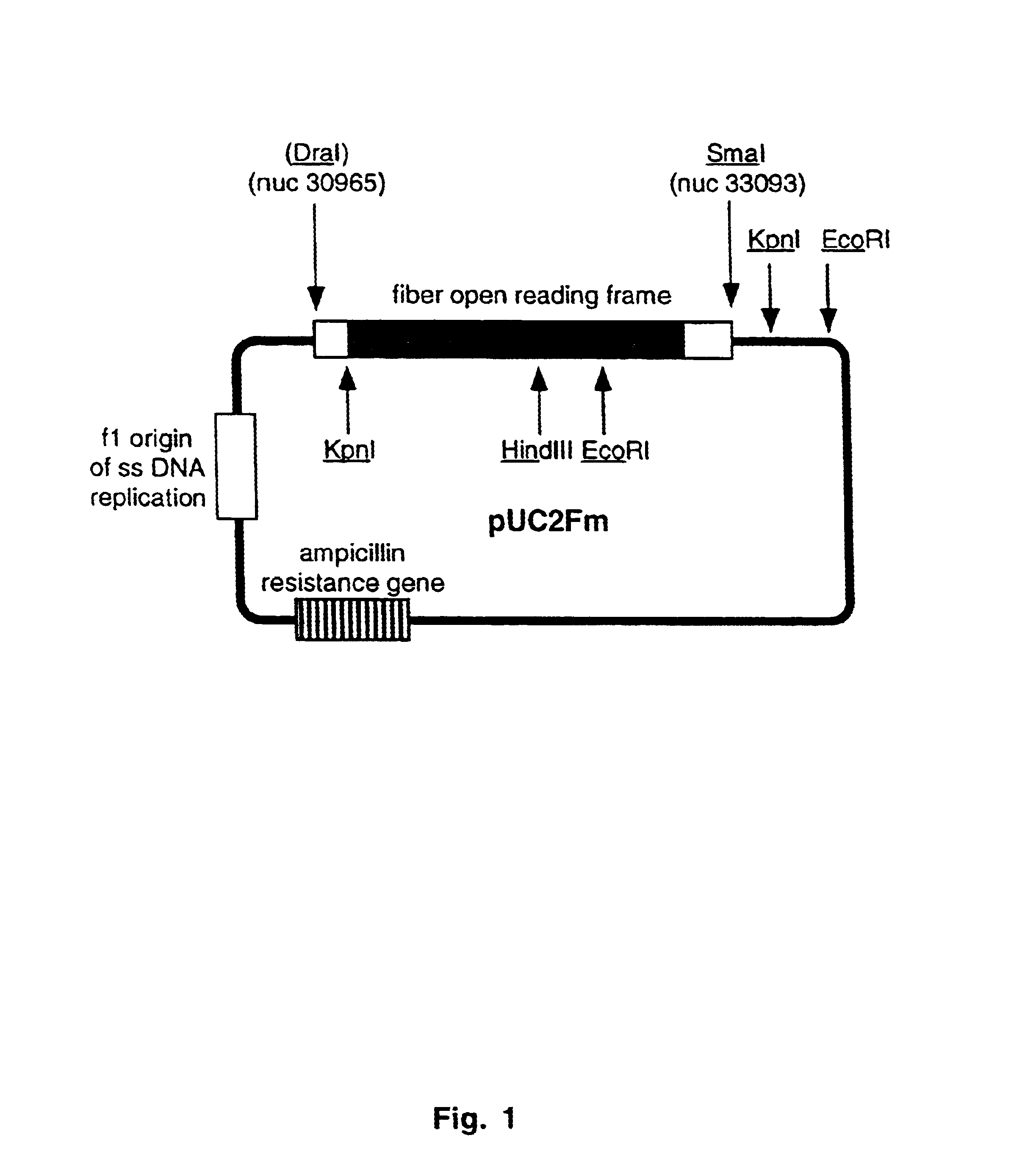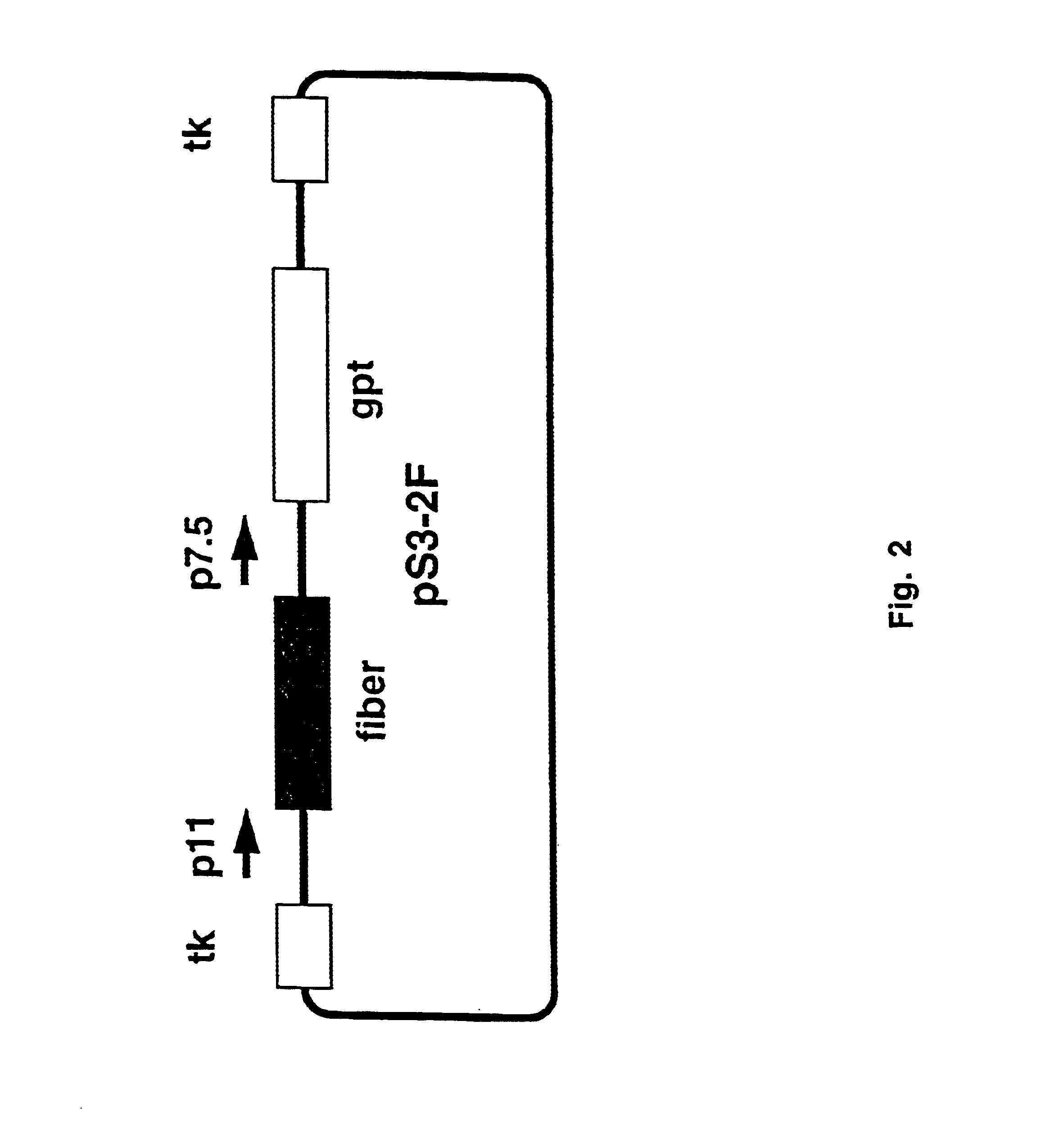Ligands added to adenovirus fiber
a technology of ligands and adenovirus fiber, which is applied in the direction of viruses, peptides, tissue culture, etc., can solve the problems of limited extent to which viruses can spread to other cell types, broad host range, and virus as vectors
- Summary
- Abstract
- Description
- Claims
- Application Information
AI Technical Summary
Benefits of technology
Problems solved by technology
Method used
Image
Examples
example 2
Production of Functional Fiber Protein That Contains a Carboxyl-Terminal Linker Ad Which Continues to Form Functional Fiber Protein Trimers
Methods
The fiber gene from adenovirus type 5 was mutated by site-directed mutagenesis to add 30 extra nucleotides onto the end of the fiber open reading frame. An oligonucleotide (oligo 6796 5' CAAACGATTC TTATTAGGAT CCAGGGGCGG AAGCAGATGC GGAGGCTGAT GGTTCTTGGG CAATGTAT 3') (Seq. ID No. 5) was used for site-directed mutagenesis of the Ad5 fiber gene cloned into pUC119. This oligonucleotide was designed to add the nucleotides that encode the peptide (PASASASASPG) (Seq. ID No. 1) onto the end of the fiber gene open reading frame. This added segment included a BamHI restriction endonuclease cleavage site at the 3' end; which was subsequently used for insertion of new ligands, as described in Example 3. Insertion of this extra DNA segment was confirmed by DNA sequencing of the plasmid DNA.
The mutated DNA segment was removed from the plasmid by digestio...
example 3
Introduction of New Ligand Specificities into the Fiber Knob
Method
Short DNA segments containing new ligand specificities were constructed from synthetic DNA oligonucleotides. The ligand specificites chosen for study were a streptavidin mimic (Seq. ID No. 6 amino acid; Seq. ID No. 7 nucleotide), a biotin mimic (Seq. ID No. 8 amino acid; Seq. ID No. 9 nucleotide), angiotensin 2 (Seq. ID No. 10 amino acid; Seq. ID No. 11 nucleotide), and bombesin (gastrin release peptide) (Seq. ID No. 12 amino acid; Seq. ID No. 13 nucleotide).
These oligonucleotides were designed with BamHI cohesive ends that could be cloned into the BamHI cleavage site developed in Example 2. The specific amino acid sequence added to fiber in Example 2 was designed to extend the new ligand away from the bulk of the fiber protein, increasing its accessibility to the new receptor molecule. The resulting modified fiber protein included a linker and a ligand, and still formed a trimer.
This example demonstrates that non-vir...
PUM
| Property | Measurement | Unit |
|---|---|---|
| molecular weight | aaaaa | aaaaa |
| molecular weight | aaaaa | aaaaa |
| temperature | aaaaa | aaaaa |
Abstract
Description
Claims
Application Information
 Login to View More
Login to View More - R&D
- Intellectual Property
- Life Sciences
- Materials
- Tech Scout
- Unparalleled Data Quality
- Higher Quality Content
- 60% Fewer Hallucinations
Browse by: Latest US Patents, China's latest patents, Technical Efficacy Thesaurus, Application Domain, Technology Topic, Popular Technical Reports.
© 2025 PatSnap. All rights reserved.Legal|Privacy policy|Modern Slavery Act Transparency Statement|Sitemap|About US| Contact US: help@patsnap.com


